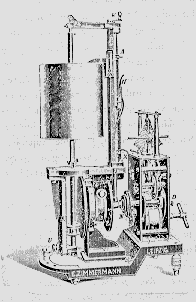
(Kymographion No. 210)
Description: Inside Cover of 1903 Zimmermann Catalog. The 1903
Zimmermann Scientific Instrument Catalog uses the "Ludwig-
Baltzar" kymograph as an emblem of the origin of the firm, using
both the renowned physiologist Carl Ludwig and the master
precision machinist of the predecessor firm, Gerhard Baltzar. The
Zimmermann firm, founded in 1887 (see the description of the
history of the Zimmermann firm), when the firm of Baltzar and
Schmidt ended, shows this standard of a variable-speed kymograph.
Carl Ludwig, who had initiated the labeling of such devices as
"kymographs (wave-writer)" in 1846, had apparently designed this
device between 1865 (when he arrived in Leipzig) and 1876 (when
Cyon shows the device) and commissioned the precision machinist
Gerhard Baltzar to produce it. Before the Ludwig-Baltzar
kymograph, Marey had designed an improved kymograph that was
produced by the Paris firm of Verdin which provided multiple
speeds and a Foucault-style governor for speed regulation. While
the Verdin kymograph could be either horizontal or vertical (the
stand, however was different in the vertical position), and could
be run at three different speeds, the Baltzar device provided
continuous speed variation by positioning the driving disk at any
position on the driven disk and provided firm mounting in either
horizontal or vertical orientation through removing the mounting
screws and reconnecting the drum to a horizontal bracket which
was supplied.
Another indication of modernity in this catalog is shown by the use of the Jugendstil (Art Nouveau) decoration around the kymograph and the ownership of the right to produce the apparatus is shown by the "E. Zimmermann" and "Leipzig" shown in large block letters on an older illustration.
Another important aspect of the catalog is the target
audience, psychologist and physiologists, i.e., that the contents
are, in addition, "psychological and physiological" instruments.
Since instruments which are primarily or exclusively
physiological form by far the bulk of the catalog, the
identification of the target audience indicates the way in which
psychologists who use instruments would consider themselves
little different from physiologists and that the discipline was
strongly modeled after physiology. (Expanded caption Copyright
1998, Edward J. Haupt)
(Source: recording)
Source of illustration: Zimmermann, E. (1903). XVIII. Preis-
Liste über psychologische und physiologische Apparate(p.
Inside Cover). Leipzig: Eduard Zimmermann.
DESCRIPTORS:
Type: component
Stimulus: N/A
System: N/A
Output: